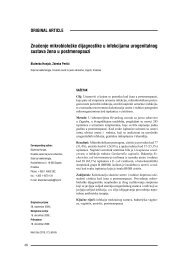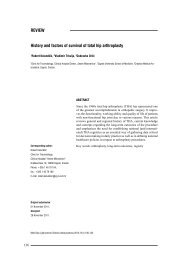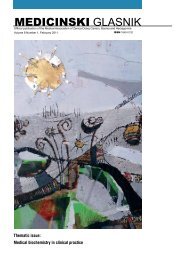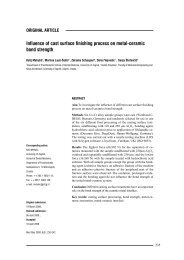MEDICINSKI GLASNIK
MEDICINSKI GLASNIK
MEDICINSKI GLASNIK
Create successful ePaper yourself
Turn your PDF publications into a flip-book with our unique Google optimized e-Paper software.
phadent N.V., Antwerpen, Belgium) is applied to<br />
the samples in group 5. The samples of group 6<br />
are kept in the solution obtained by mixing 50 ml<br />
of distilled water and 50 ml of 32% hydrochloric<br />
acid for 30 minutes. After etching these samples<br />
are first of all washed in distilled water, and then<br />
in the compound of ethyl alcohol and acetone in<br />
ratio 1:1. Figure 1 shows the characteristic surface<br />
of the sample prepared in this way recorded<br />
by a scanning electronic microscope (Tescan<br />
Vega TS5136LS, Tescan, Brno, Czech R) with<br />
the secondary electron detector (SE).<br />
Along the middle of thus prepared metal<br />
plates the ceramics (Duceram Kiss, DeguDent,<br />
Hanau-Wolfgang, Germany) is fired (ceramic<br />
furnace Focus 2006, Shenpaz, Tel Aviv, Israel) in<br />
the length of 8 mm, width of 3 mm, and thickness<br />
of 1 mm. The ceramics corresponds to the manufacturer’s<br />
instructions and belongs to the group<br />
of ceramics with the fired temperature of up to<br />
980°C, suitable for coating of the mentioned alloy.<br />
The samples are tested by bending in three points<br />
on the tester machine (LRX Lloyd Instruments,<br />
Fareham, Great Britain) with installed Nexygen<br />
programme for the processing of results. The<br />
samples are set so that the surface with ceramics<br />
is turned opposite to the pin, and the metal part<br />
resting on the supports at a distance of 20 mm,<br />
and the diameter of pin that loads the sample is 1<br />
mm. The shift of pin is constant during testing at<br />
a speed of 1.5 mm/min, and the testing continues<br />
Figure 3. Typical areas during three-point bending test<br />
Mehulić et al Surface finishing and bond strength<br />
until the fracture, i.e. to full separation of the ceramics<br />
from the metal.<br />
Testing procedure has been carried out according<br />
to the guidelines given in ISO 9693<br />
(15).<br />
After testing the samples type of fracture surfaces<br />
(cohesive, adhesive or cohesive-adhesive)<br />
were examined by scanning electronic microscope<br />
(Tescan Vega TS5136LS, Tescan, Brno, Czech R).<br />
The same person has performed all the tests.<br />
The multiple range tests, Fischer’s LSD test<br />
and ANOVA have been used for statistic analysis.<br />
RESULTS<br />
The results of 3-point bending test performed<br />
on 6 groups of specimens, (each group has three<br />
specimens) are presented in Figure 2.<br />
The diagrams obtained by testing on the tester<br />
and presented in Figure 2 show the same trend,<br />
i.e. the behaviour of all samples during testing is<br />
inter-compatible. Therefore, Figure 3 can generally<br />
explain the behaviour of all metal-ceramic<br />
systems in a three-point flexure bond test.<br />
According to Figure 3 it is possible to define<br />
three characteristic areas during testing. The<br />
beginning of testing where the force-deflection<br />
diagram is a horizontal line, i.e. the pin is lowered<br />
without increase of force, represents the first<br />
area. Such behaviour is caused by preparation of<br />
testing and represents the period from beginning<br />
of testing to the moment of achieving the predefined<br />
pre-load.<br />
Point A (Figure 3), where a sudden increase<br />
in force is noticed, represents the moment of<br />
contact between the pin and the sample and the<br />
actual beginning of the testing area 2. The linear<br />
part of the diagram that follows from this point<br />
represents common resistance to flexing of the<br />
metal-ceramic sample, since in this area the bond<br />
between metal and ceramics is still strong.<br />
Point B (Figure 3) represents the start of the<br />
third area, i.e. the moment of loosening of the bond<br />
between metal and ceramics and the moment at<br />
239












